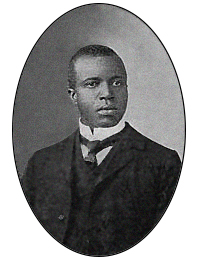The gilded age saw the emergence of very recognizable forms of music in America. As a result of slavery, African American music developed as its own genre, influenced by African rhythms and traditions. The combination of this genre with Western classical music, particularly marches, such as those composed by John Philip Sousa, led to a genre of music, known as ragtime.
Ragtime is characterized by syncopated rhythms. Put simply, this means that the notes fall on the offbeats, giving the music a light feel, well-suited for dancing. In contrast with early jazz music, ragtime was primarily spread by the sale of sheet music. whereas early jazz spread primarily through performances.
Perhaps the most famous ragtime musician was Scott Joplin. Joplin was born in 1868 in Texas into a family of railway laborers. Details around his early life are hazy, but it is known that his mother was a free black from Kentucky, while his father was a freed slave from North Carolina. While most Americans nowadays might not recognize Joplin's name, his music is recognizable to almost everybody. His most popular piece nowadays is probably "The Entertainer". The defining characteristics of ragtime are easily identifiable in this piece, with its offbeats and light dance feel.
Ragtime was a predecessor to jazz, which grew out of New Orleans in the early 20th century. However, more surprisingly, ragtime had an influence on European classical composers of the time. Composers such as Claude Debussy and Antonín Dvořák were influenced by American ragtime music and wrote pieces of their own that copied elements from ragtime. Again, while most Americans would not be able to identify it by name, many have heard (at least the intro of) Debussy's "Golliwogg's Cakewalk".
The increasing urbanization of the United States and the emergence of a need for distraction from city life allowed forms of music such as ragtime and later jazz to take off during the gilded age. There is no doubt that ragtime and early jazz paved the way for truly American music to make its way into the world, and define the American culture on the musical scene, differentiating itself from Europe in this sense.
 '
'Scott Joplin
Sources:
http://www.biography.com/people/scott-joplin-9357953
http://memory.loc.gov/diglib/ihas/loc.natlib.ihas.200035811/default.html
http://jazz.about.com/od/historyjazztimeline/a/ragtime.htm
Creative and insightful post on ragtime Michael! I especially liked the pictures and links to relevant information. Why do you suppose people like Joplin are not well known, but their music is? Additionally, it is interesting to see that so many ragtime artists were African-American, and do you think this had an effect on their careers?
ReplyDeleteFor more information on Scott Joplin:
https://www.britannica.com/biography/Scott-Joplin
This is a very interesting post. It is always intriguing to see how the people spend their time during these eras of progression. While the books mainly focus on the main events, it's nice to take a step back and see the leisures common people engage in. In this instance I wonder that since ragtime is influenced by African American culture, I would assume that white people don't enjoy it as much.
ReplyDeleteInteresting read! Adding on to Alex's idea on how white people viewed ragtime in a negative way, many whites thought that ragtime music was "dangerous" to their health; doctors thought that people could develop heart or brain issues from uneven and very upbeat rhythms, which were one of the main characteristics of the ragtime music.
ReplyDeletesource: http://www.marktsmall.com/history-blog.html